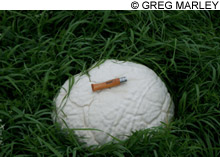It's a hot, sticky July afternoon and I'm riding shotgun in Uncle Bob's pick-up truck. We've just spent the past couple hours walking off-trail through the woods, and we're doing much better than I had expected.
I spotted the first fungus of the day — a brittle Russula variety not twenty paces into the woods — but Bob really perked up when he glimpsed flashes of bright yellow at the trail's edge. During the drive over, he had been talking nonstop about chanterelles, a delicious and highly sought-after edible mushroom that begins sprouting mid-July. Chanterelles are one of his favorite mushrooms, and as I would come to learn, one of the more popular edibles in Maine. By now, Bob can spot flashes of yellow from yards away. He led me to the patch, crouched, and let out a small groan. "False chanterelles," he said, bending the mushroom's stem to look underneath the cap. Bob explained that real chanterelles are mustard yellow and smell faintly of apricots. These were more orange-y, and had sharper gills than what we were looking for. "Don't worry. I know a good spot for chanterelles," he reassured me. "It'll be packed with them."
We were somewhere in southern Maine — but I can't say where. (Mushroom foragers are secretive and territorial.) Bob lives around here. He's a farmer and an Army veteran, and since he retired, most days he tends to an ample garden behind his home. I might also mention that he's not my uncle; "Uncle Bob" is how he introduces himself. In fact, Bob and I had only just met earlier in the day, when he somewhat surprisingly agreed to let me tag along on one of his forays. I knew that he sourced a local restaurant (where I occasionally wait tables) with vegetables grown in his garden, but vegetables weren't what I was interested in. Bob's been mushrooming off and on since the mid-'60s, and though he's not always terrific with identification, he knows what he's looking for, what's edible, and what he might be able to sell.
Bob had wrapped our findings individually in paper towels and nestled them in the console of his truck's fold-down armrest. On our walk, I'd stumbled upon some Indian Pipes (a/k/a Corpse Plants) and a lilac brown bolete, and Bob had collected a gilled polypore and what he thinks might be some young Amanita buttons. We both found several more false chanterelles. Gorgeous little things, but definitely not edible, and not exactly what Bob was looking for.
 |
Now Bob pulls the truck over near a small cemetery and we both step out. He grabs his bucket ("you're supposed to use a basket, but I use this so people don't know what I'm up to") and we stroll along the ridge abutting the cemetery gate. He points out several tiny mushrooms growing on the grassy shelf. He thinks they could be chanterelles, but even so, are too young to pluck. A large truck passes by as I lean forward and inspect the fruiting bodies. When it recedes, Bob kindly reminds me that whenever he thinks people can see him looking for mushrooms, he pretends to be just another guy taking a walk, and suggests I do the same. The secret dance of the forager is even trickier than I had thought. I apologize and we pass through the cemetery gate.Though no one is in sight, Bob and I take no chances inside the cemetery. With an almost exaggerated casualness, we pass silently between the graves before Bob ushers me quickly through a frame in the hedges. Growing in a small, dry clearing of pine needles, we see ten gorgeous, unmistakable chanterelles.
Bob was visibly disappointed. "Damn," he says, "usually there's twice this many." We crouch down and inspect them — the winding stems, blunt gills, and mustard-yellow coloration — and pluck the big ones, enough to use in two or three meals. "It really has been a dry summer," Bob notes. When we leave the site and get back in the truck, Bob puts the day's work into perspective. We'd found a good number of species, but he estimates that the sum of the edibles might only net $15, tops. "Most of the time, I don't even think about the money," he says as we pull into the street. "It's the fun of finding them!"
Ahh . . . summer in Maine. A bit on the dry side, but we'll take it. It's a time for swimming, bicycling, and reading novels on the beach. And for a growing number of foragers like Uncle Bob, the Maine summer signals the beginning of mushroom season.
In fact, interest in wild mushrooms is growing rapidly across the US. Local food movements and increased access to field and online guides have helped to nurture a newfound cultural appreciation for mushrooms, and while it won't soon replace the lobster, potato, or blueberry, it's sure getting a lot of attention. So much in fact, that many are looking at Maine to see what the future of American mushrooming will bring.